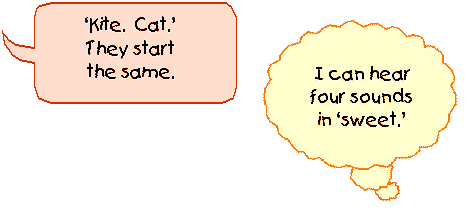A Floor for ![]() :
:
What Is Phonemic Awareness?
Why do some children learn to read so easily, while others struggle?
Thirty years of research funded by the National Institutes of Health has found an answer:
Successful children have a special ‘sound foundation.’
They can play with speech sounds in their ‘Mind’s Ear.’![]()
The ‘sound foundation’ of successful reading is known as Phonemic Awareness.
Phonemic Awareness is a set of teachable skills,
and children do not have to be particularly ‘intelligent’
to learn them.![]()
Phonemic Awareness is not about the spelling of words. It is all about their sounds

![]()
Phonemic awareness is the understanding that spoken words and syllables are made up of sequences of speech sounds.
For example, the word ‘shows’ contains three individual speech sounds:
‘sh’
‘oh’
‘z’
(Think sound, not spelling.)![]()
Phonemic Awareness is the ability to think about and mentally play with the sounds in speech.
Children are using Phonemic Awareness when they do things like
- rhyme
- clap syllables
- hear individual sounds within words
- blend sounds into words
- pull words apart into individual sounds
- add and subtract sounds from words
- speak Pig Latin or sing the Name Game song
![]()
Phonemic Awareness is necessary for phonics to work properly.
But do not let children ‘cheat’ by seeing the letters as they first learn Phonemic Awareness games.
The essence of Phonemic Awareness
is learning to do these things in the ‘Mind’s Ear’--no peeking!
The ‘Mind’s Ear’ itself needs to be strong enough to work smoothly on its own, in the background of awareness.
This is what allows for fluent Phonics, with plenty of attention left over for Reading Comprehension.
(Once the ‘Mind’s Ear’ is strong enough to play with sounds no-peeking, then students can peek--then they can apply their ‘Mind’s Ear’ skills to their written Phonics.)
![]()
Phonemic Awareness should be taught starting at preschool age.
Even babies can learn about speech sounds
But it’s never too late to back up and build strong Phonemic Awareness.
Phonemic Awareness continues to develop as children learn Phonics.
![]()
Basic Auditory Skill and Phonemic Awareness skills list
The easiest tasks are at the top of the list. They build toward the most difficult at the bottom.
Rhyme:
Discern and supply rhyming words
Auditory Discrimination:
Discern speech sounds from one another
Phoneme Blending:
Blend isolated sounds into real or nonsense words
Word-to-Word Match:
Tell if two words share a sound in common.
For example, do they have the same first sound?
Sound Isolation:
Discern individual phonemes in a word.
For example, repeat just the first or last sound of a word.
Phoneme Counting:
Tap out the number of sounds in a word.
‘Shoe’ has two sounds: sh, oo.
Phoneme Segmentation:
Separate and say the individual sounds of a word in order
Phoneme Deletion:
Say what would be left if you removed part of a word![]()
Benefits of Phonemic Awareness
Children who play Phonemic Awareness games build their ability
to recall speech sounds in their ‘Mind’s Ear.’
Children who can recall speech sounds in their ‘Mind’s Ear’
are equipped to learn Rapid-Accurate Naming of letter-sounds.
Children who play Phonemic Awareness games build their ability
to blend and pull apart the sounds of words in their ‘Mind’s Ear.’
Children who can blend and pull apart the sounds of words
in their ‘Mind’s Ear’
are equipped to sound out and to spell words using Phonics.![]()
Even the weirdness of English spelling is less troublesome to children skilled in Phonemic Awareness.
Listen to the pronunciation of the red letters:
Father Fat Famous
Cat Kite Chemistry Rick
Ought Tough Though Through Hiccough
Okay, let me admit that I am still troubled by the whole ‘ough’ issue.![]()
The point is:
In English, one letter can make several different sounds.
In English, one sound can have several different letters!
But in English, one sound is . . . one sound.
Simple, accurate, reliable.
So as children work and play with sounds in their ‘Mind’s Ear’ without involving Phonics--written letters--they are building something that is true and consistent.
And they are building a ‘Mind’s Ear’ strong enough to handle Phonics fluently.
(Unlike the alphabet, the Playful Sounds represent the truth about speech sounds.)
![]()
Phonemic Awareness--the stable Floor, the sound foundation--helps learners to build the Phonics ‘walls’ of the Reading Treehouse.
Research confirms:
Learners who have this stable Floor, this sound foundation
build their Phonics more easily, and Phonics always works better for them,
than for learners without this sound foundation.
Very young learners, kids who are not naturally ‘auditory learners,’ or students at risk, can begin at the very beginning by learning the sounds of speech with Playful Sounds.
![]()
Short Cut Through the Treehouse ~ The Whole Treehouse
More on this topic: THE FLOOR: Power and Fluency
Through Phonemic Awareness



